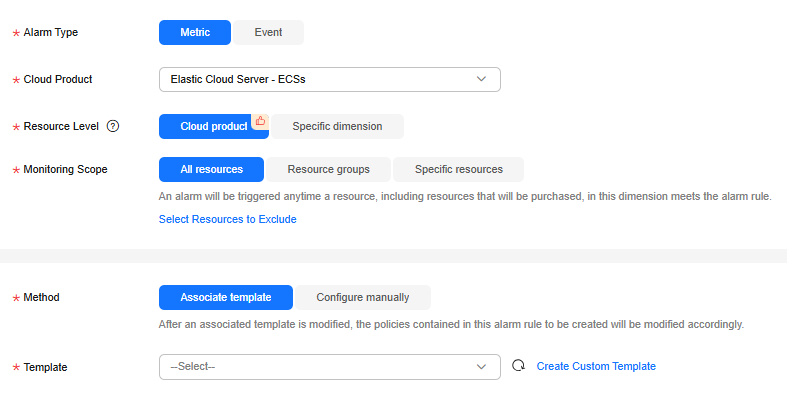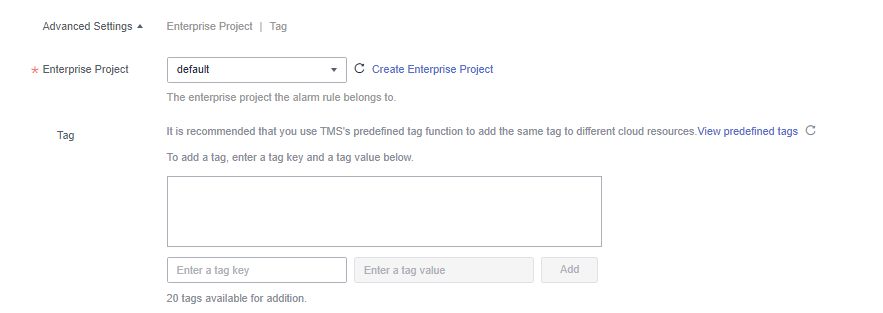Creating an Alarm Rule and Notifications
To monitor the usage of cloud service resources or key operations on them, you can create an alarm rule. After the alarm rule is created, if a metric reaches the specified threshold or the specified event occurs, Cloud Eye immediately informs you of the exception through SMN.
This topic describes how to create an alarm rule.
Prerequisites
|
Alarm Type |
Prerequisites |
|---|---|
|
Metric |
|
|
Event |
Before creating an alarm rule for a custom event, ensure that the event source is the same as that specified in Reporting Events. |
Creating an Alarm Rule
- Log in to the Cloud Eye console.
- In the navigation pane, choose Alarm Management > Alarm Rules.
- Click Create Alarm Rule in the upper right corner.
- On the Create Alarm Rule page, configure parameters.
- Configure basic information of the alarm rule.
Figure 1 Basic information

Table 1 Name and Description Parameter
Description
Name
Name of the alarm rule. The name is automatically generated, but you can change it to a custom one. The rule name cannot exceed 128 characters and can contain only letters, digits, underscores (_), and hyphens (-).
Description
Alarm rule description. The value can contain a maximum of 256 characters. This parameter is optional.
- Select monitored objects and configure alarm parameters.
Figure 2 Configuring an alarm rule

Table 2 Alarm rule parameters Parameter
Description
Example Value
Alarm Type
Alarm type to which the alarm rule will apply. The type can be Metric or Event. For details about how to select an alarm type, see Table 1.
Metric
Cloud Product
Select the cloud product you want to monitor. This parameter is only available if you select Metric for Alarm Type.
For details about supported cloud products and their metrics, see Cloud Product Metrics.
Elastic Cloud Server - ECSs
Resource Level
Resource level of the monitored object. This parameter is only available if Alarm Type is set to Metric. The value can be Cloud product (recommended) or Specific dimension.
Take ECS as an example. ECSs is the cloud product. Specific dimensions are disks, mount points, processes, and more.
NOTE:If you select Cloud product for Resource Level, metrics across dimensions (such as Disk Usage and CPU Usage) can be configured in the same alarm rule. If you select Specific dimension, only metrics of the specified dimension can be configured for the same alarm rule
Cloud product
Monitoring Scope
Monitoring scope the alarm rule applies to.
- All resources: An alarm will be triggered if any resource of the current cloud product meets the alarm policy. To exclude resources that do not need to be monitored, click Select Resources to Exclude.
- Resource groups: An alarm will be triggered if any resource in the selected resource group meets the alarm policy. To exclude resources that do not need to be monitored, click Select Resources to Exclude.
- Specific resources: Click Select Specific Resources next to Instance to select resources.
NOTE:- If Alarm Type is set to Metric, you can select Resource groups, All resources, or Specific resources.
- If Alarm Type is set to Event and Event Type is set to System event, you can configure the monitoring scope. Currently, Resource groups is only available for DDS, RDS, and DCS event alarms.
Specific resources
Group
When Monitoring Scope is set to Resource groups, you need to select a group. If no resource group meets you needs, click Create Resource Group to create one.
After selecting a resource group from the drop-down list, you can click View Resources in a Group to view the details of resources in the group. After an alarm rule is configured, the group cannot be modified.
N/A
Instance
When Monitoring Scope is set to Specific resources, you need to select the monitored objects for the alarm rule.
Click Select Specific Resources to select desired resources.
N/A
Event Type
This parameter is only available if Alarm Type is set to Event. You can select either System event or Custom event. For details about the events supported by each cloud service, see Events Supported by Event Monitoring.
System event
Event Source
This parameter is only available if Alarm Type is set to Event.
- If Event Type is set to System event, select the cloud service from which the event comes.
- If Event Type is set to Custom event, the event source must be the same as that of the reported source and is written in the service.item format. For details about how to report an event, see Reporting Events.
Elastic Cloud Server
Method
Select a method for configuring an alarm rule. For metric alarm rules or system event alarm rules, you can customize a policy or use a preset template to create one. For custom event alarm rules, you can only customize a policy.
- Configure manually: You can create a custom alarm policy as needed.
- Associate template: If the same alarm rule needs to be configured for multiple groups of resources under the same cloud product, you can use an alarm template to simplify operations.
Configure manually
Template
If Method is set to Associate template, you need to select a template.
You can select a default or custom template.
NOTE:An alarm template may contain alarm policies of multiple cloud products or different dimensions of the same cloud product. When you create an alarm rule, the alarm policies vary according to the resource level.
- If Resource Level is set to Cloud product, all alarm policies of the cloud product in the alarm template will be synchronized to the alarm rule.
- If Resource Level is set to Specific dimension, alarm policies of the same dimension as the current resource in the alarm template will be added to the alarm rule.
N/A
Alarm Policy
If you select Configure manually for Method, you need to configure alarm policies.
- When you set Alarm Type to Metric, whether to trigger an alarm depends on whether the data in consecutive periods reaches the threshold. For example, Cloud Eye triggers an alarm if the average CPU usage of the monitored object is 80% or more for three consecutive 5-minute periods.
- If you set Alarm Type is to Event and a specified event occurs, an alarm is triggered. For example, an alarm is triggered if a VM is restarted.
For details about alarm policy parameters, see Alarm Policies.
You can add up to 50 alarm policies for a single alarm rule. You can choose to send alarm notifications when any of the policies is met or when all policies are met.
N/A
Alarm Severity
Alarm severity, which can be Critical, Major, Minor, or Informational.
Major
- Configure alarm notifications.
Table 3 Parameters for configuring alarm notifications Parameter
Description
Alarm Notification
Whether to send alarm notifications by SMS, email or HTTP or HTTPS. This parameter is enabled by default.
Recipient
Target recipient of alarm notifications. You can select the account contact or a topic name. This parameter is available only if Notified By is set to Topic subscriptions.
- Account contact: Enter the phone number and email address of the registered account.
- A topic is used to publish messages and subscribe to notifications. If there is no topic you need, create one first and add subscriptions to it. For details, see Creating a Topic and Adding Subscriptions.
Notification Window
This parameter is only available if you set Notified By to Notification groups or Topic subscriptions.
Time window during which Cloud Eye sends notifications.
For example, if the notification window is set to 08:00:00 to 20:00:00, notifications are sent only within this specified time range when a metric reaches the specified threshold or a specified event occurs.
Time Zone
Time zone for the alarm notification window. By default, it matches the time zone of the client server, but can be manually configured.
Trigger Condition
This parameter is only available if you set Notified By to Notification groups or Topic subscriptions.
- If Alarm Type is set to Metric, you can select Generated alarm, Cleared alarm, or both.
- When the alarm type is set to Event, you can only select Generated alarm for Trigger Condition.
- Set parameters in Advanced Settings.
Figure 3 Advanced settings

Table 4 Enterprise Project and Tag Parameter
Description
Enterprise Project
Enterprise project that the alarm rule belongs to. Only users with the enterprise project permissions can manage the alarm rule. To create an enterprise project, see Creating an Enterprise Project.
Tag
Each tag is a key-value pair. You can tag cloud resources to easily categorize and search for them. You are advised to create predefined tags in TMS. For details, see Creating Predefined Tags.
- A key can contain up to 128 characters, and a value can contain up to 225 characters.
- You can create up to 20 tags.
- Click Create.
After the alarm rule is created, if a metric reaches the specified threshold, Cloud Eye immediately informs you of the exception through SMN.
Feedback
Was this page helpful?
Provide feedbackThank you very much for your feedback. We will continue working to improve the documentation.






